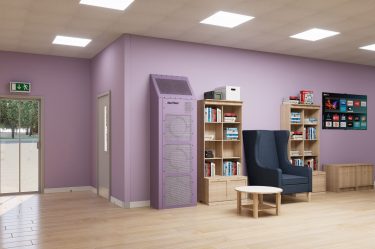
Indoor Air Quality (IAQ) is no longer just a comfort issue; it’s a fundamental determinant of health, performance, and long-term sustainability across all built environments: hospitals, schools, offices, transport hubs, and care settings.
But while scientific consensus has moved decisively toward performance-based clean air standards, regulatory frameworks remain outdated, fragmented, and dangerously slow to evolve.
At AirPurity, we are not waiting for policy to catch up. Our Advanced Environmental Management Systems (AEMS) are designed to exceed current expectations and meet the standards that will define the next decade.
The Global Science Is Clear
The World Health Organization’s 2021 roadmap declared indoor air to be as important as safe food and water, and called for IAQ to be treated as a public health priority across all sectors, not just healthcare (WHO, 2021).
This came in response to growing global evidence that poor indoor air contributes to a wide range of health conditions, from respiratory and cardiovascular diseases to cognitive decline and reduced productivity. The WHO estimates 3.2 million premature deaths annually are attributable to indoor air pollution (WHO, 2022).
But UK Regulation Is Still Playing Catch-Up
In the UK, several documents guide air quality in buildings, but none provide binding standards for airborne pathogen control or IAQ performance:
- Building Regulations Part F (updated 2022; effective 2023) sets minimum background ventilation rates for non-residential buildings: 10 litres/second/person, or 1 L/s/m², whichever is greater (Gov.uk, 2022).
- Approved Document F also recommends a purge ventilation rate of four air changes per hour (ACH) in certain circumstances but this is based on comfort and CO₂, not pathogen load or particulate control.
- The Workplace (Health, Safety & Welfare) Regulations 1992 require “a sufficient quantity of fresh or purified air,” but do not define how air is to be measured, filtered, or disinfected (HSE, 1992).
While guidance from the Health and Safety Executive (HSE) recommends maintaining indoor CO₂ below 800–1,500 ppm and highlights air cleaning as an option where ventilation is limited, there is no legal requirement to implement filtration or disinfection (HSE, 2021).
In short, UK law is built on 20th-century paradigms: odour control, comfort ventilation, and energy conservation, not airborne infection prevention or ultrafine particle mitigation.
ASHRAE 241: A Glimpse of the Future
In contrast, the American Society of Heating, Refrigerating and Air-Conditioning Engineers (ASHRAE) released Standard 241 in 2023, a revolutionary shift from design-based guidelines to performance-based outcomes.
ASHRAE 241 introduces the concept of Equivalent Clean Airflow (ECA), a measurable outcome that combines outdoor air, filtration, and air cleaning to achieve target pathogen removal rates. It also provides a framework for buildings to operate under Infection Risk Management Mode (IRMM), ready to adapt during health emergencies (ASHRAE, 2023).
While not yet adopted into UK regulation, ASHRAE 241 is rapidly gaining traction as the new gold standard in risk‑based IAQ.
AirPurity: Designed for What’s Next
At AirPurity, our systems were developed from the ground up to answer the question that regulators are only just beginning to ask:
“What does it take to actually make indoor air safer, not just fresher?”
Our Advanced Environmental Management Systems (AEMS) were conceived during the AAirDS research project at Addenbrooke’s Hospital (UKHSA-funded), and have since been deployed in live environments from healthcare to commercial and secure settings.
- Designed to meet ASHRAE 241-aligned performance targets, including pathogen removal and ECA delivery.
- Option to fully ligature-proof, discreet, and engineered for complex spaces, including mental health units, airports, SEND schools, and military bases.
- Enable real-world reduction of airborne particulates and pathogens, not just dilution of CO₂.
Unlike passive systems, AirPurity units actively manage air within the space, continually, drawing, filtering, disinfecting, and recirculating clean air.
Why Mandates Matter — But Readiness Matters More
While regulation is slowly evolving, health risks and liability exposure are not waiting.
Under the Health and Safety at Work Act 1974, employers must ensure the health and safety of employees and others “so far as is reasonably practicable.” As science increasingly confirms that clean air is essential to health, the bar for “reasonably practicable” is rising, particularly in high-occupancy or vulnerable settings.
Employers, facilities managers, and building designers must now consider whether minimum compliance is ethically or legally sufficient or whether proactive air management is the new duty of care.
Why We Must Push for Regulation Change, Now
- Public health demands more: With WHO estimates showing millions of lives lost to avoidable indoor pollution, status‑quo ventilation is unacceptable.
- Pandemic preparedness demands action: ASHRAE 241 is designed to future‑proof buildings, yet few NHS Trusts or UK facilities are even aware of it.
- Legal risk is rising: Under the Health and Safety at Work Act 1974 and COSHH, employers must underpin risk assessments with practicable controls. Passive ventilation alone may not suffice if outbreaks can be traced to poor air quality.
Standardised regulation will follow the science eventually. But until that moment, early adopters like AirPurity give organisations a competitive and ethical advantage.
A Call to Industry Leaders
Regulations may still lag, but that’s not a reason to wait. It’s a reason to lead.
- Specify performance-based IAQ outcomes in tenders and designs, not just background ventilation.
- Implement filtration and disinfection in complex environments, especially where natural ventilation is not viable.
- Support regulatory modernisation by embedding performance-monitoring and adaptive risk protocols.
AirPurity is already delivering on what the future demands. We are not in the business of minimum standards. We are building the new benchmark.
“Clinically validated. Ethically grounded. Technically unmatched”.
References (Harvard Style)
- ASHRAE (2023) Standard 241: Control of Infectious Aerosols, American Society of Heating, Refrigerating and Air-Conditioning Engineers.
- GOV.UK (2022) Building Regulations: Ventilation (Approved Document F). Available at: https://www.gov.uk/government/publications/ventilation-approved-document-f
- Health and Safety Executive (1992) The Workplace (Health, Safety and Welfare) Regulations 1992, Regulation 6.
- Health and Safety Executive (2021) Ventilation and air conditioning during the coronavirus (COVID-19) pandemic. Available at: https://www.hse.gov.uk/coronavirus/equipment-and-machinery/air-conditioning-and-ventilation/index.htm
- WHO (2021) Roadmap to Improve and Ensure Good Indoor Ventilation in the Context of COVID-19, World Health Organization.
- WHO (2022) Burden of Disease from Indoor Air Pollution. Available at: https://www.who.int/data/gho/data/themes/topics/topic-details/GHO/burden-of-disease-from-indoor-air-pollution



